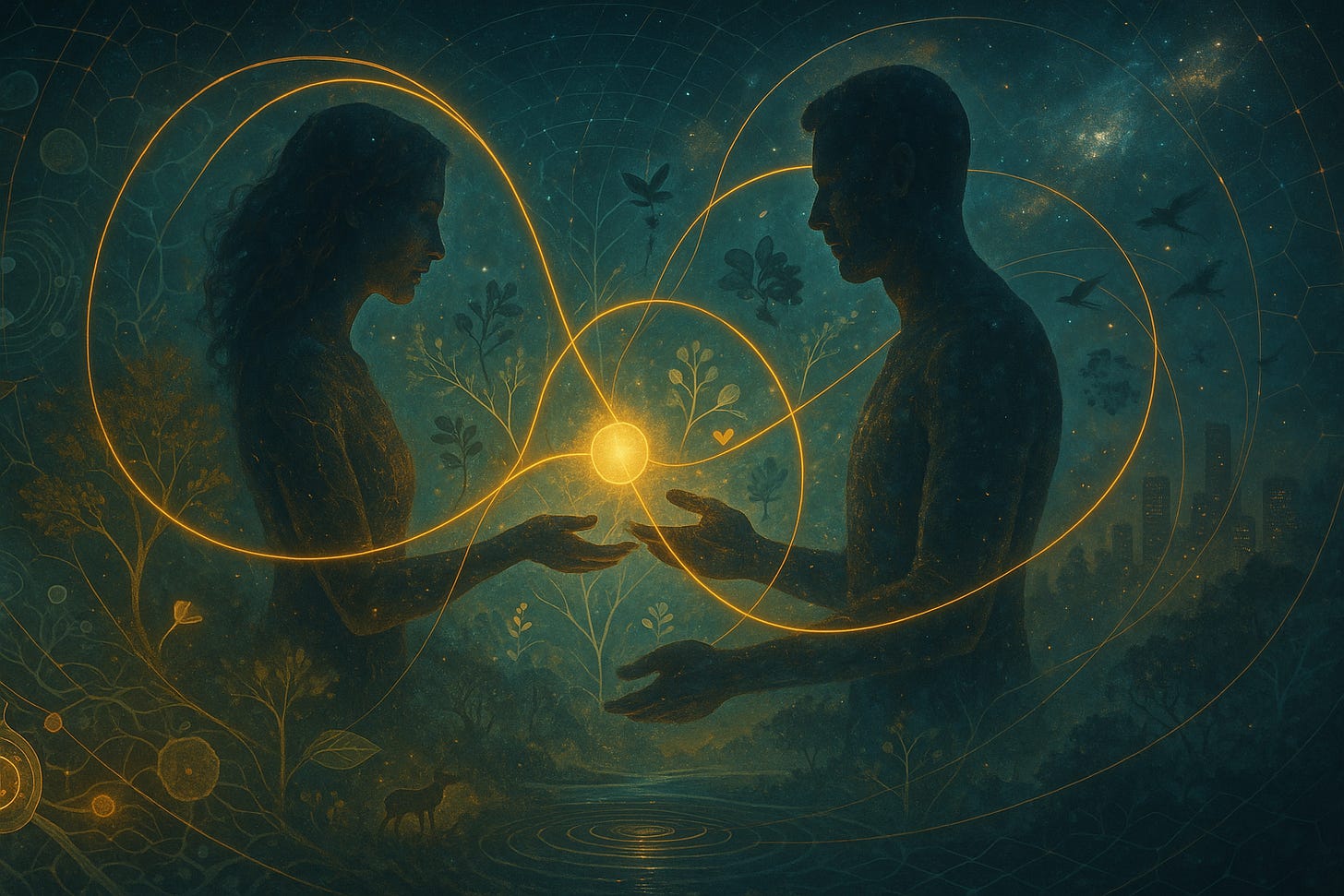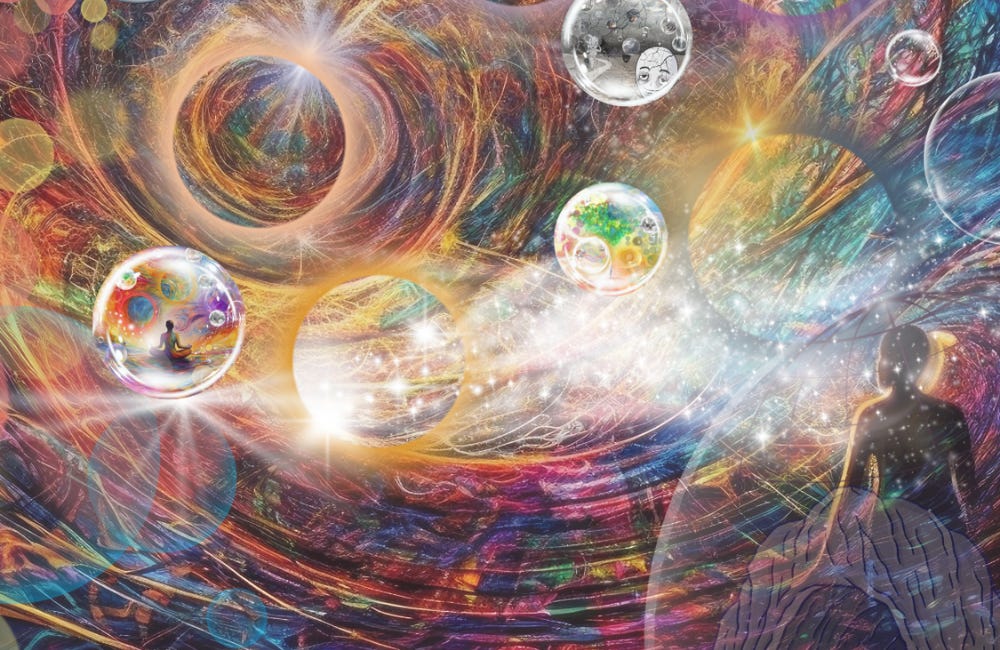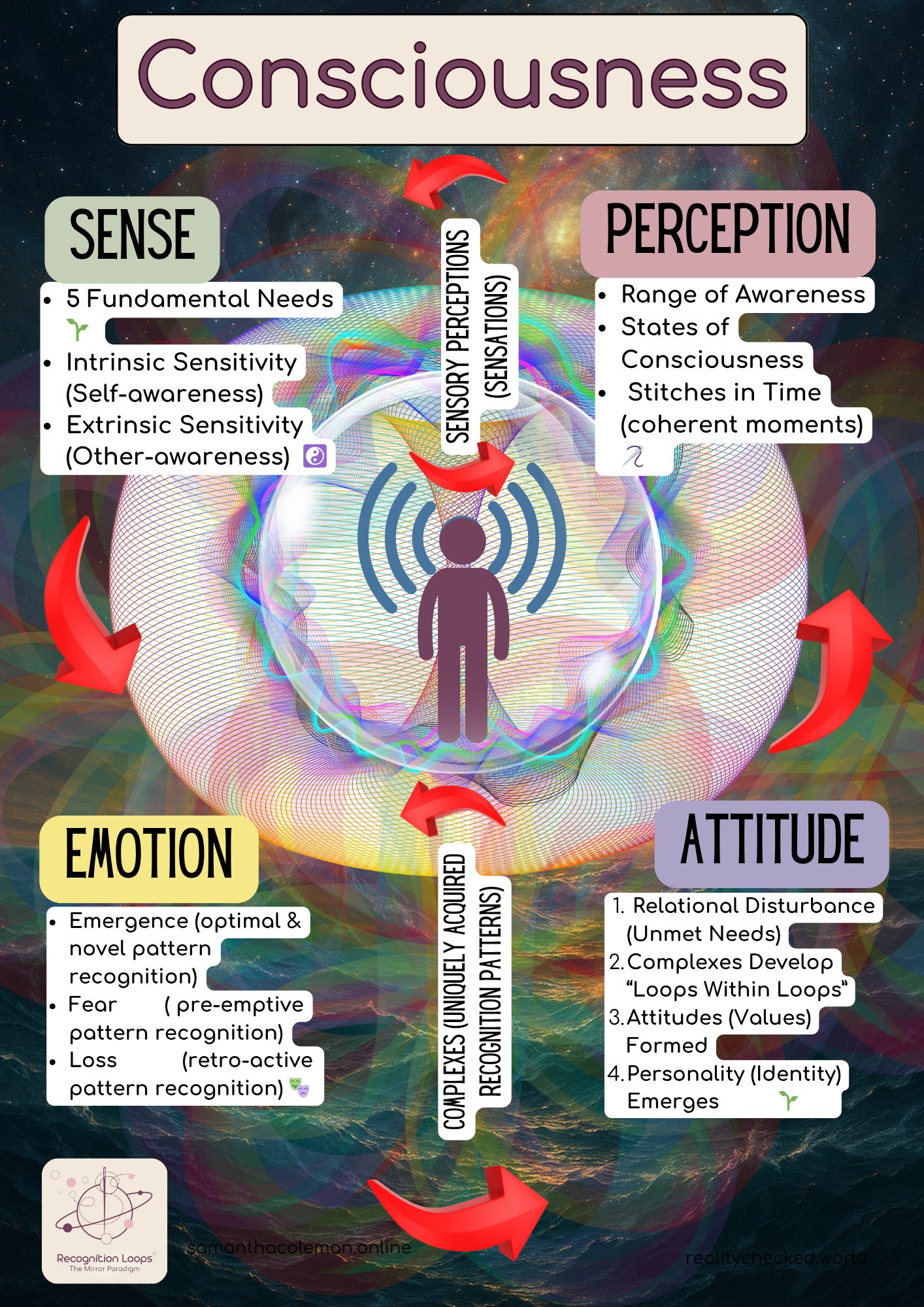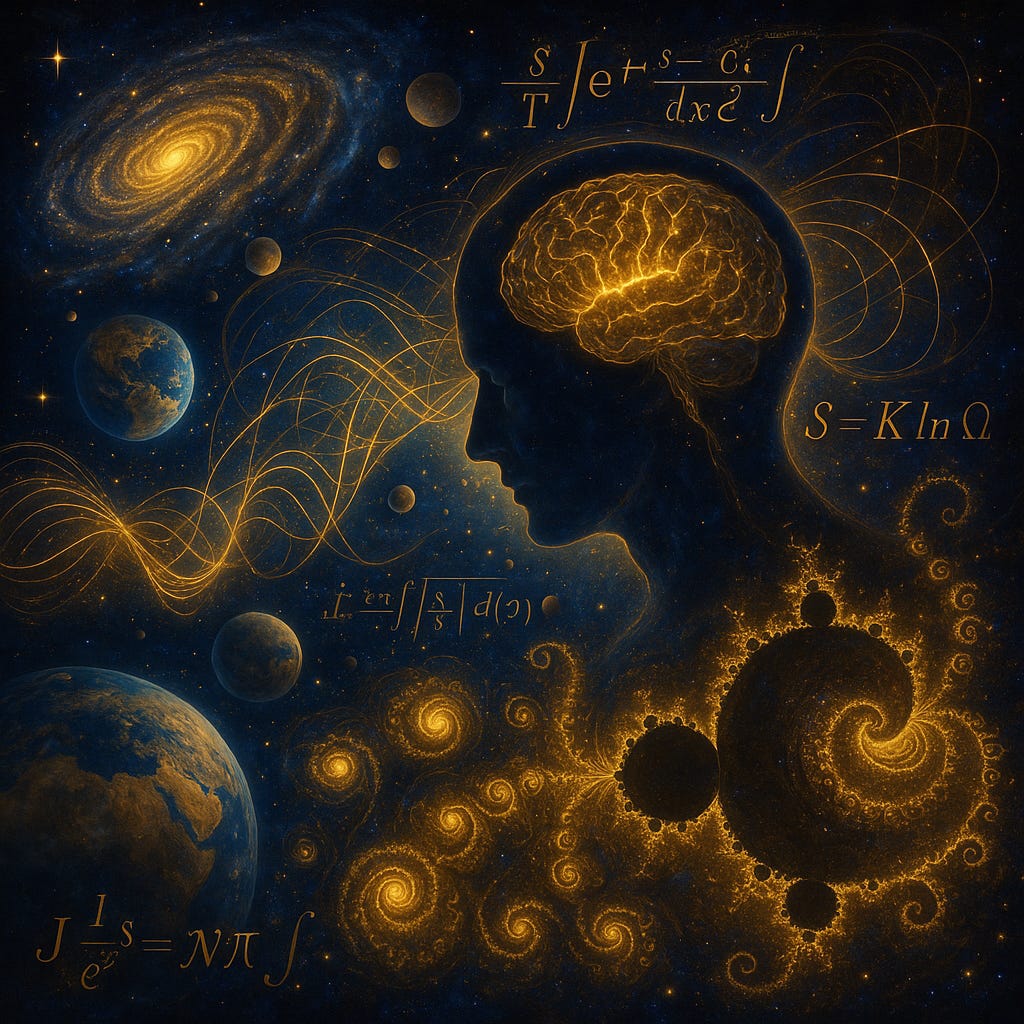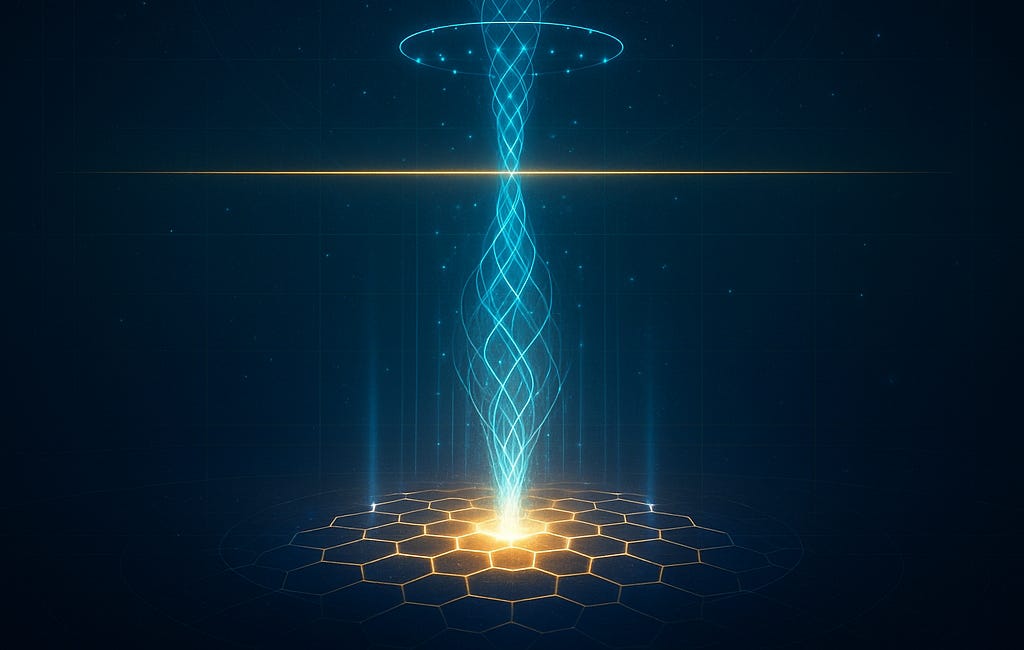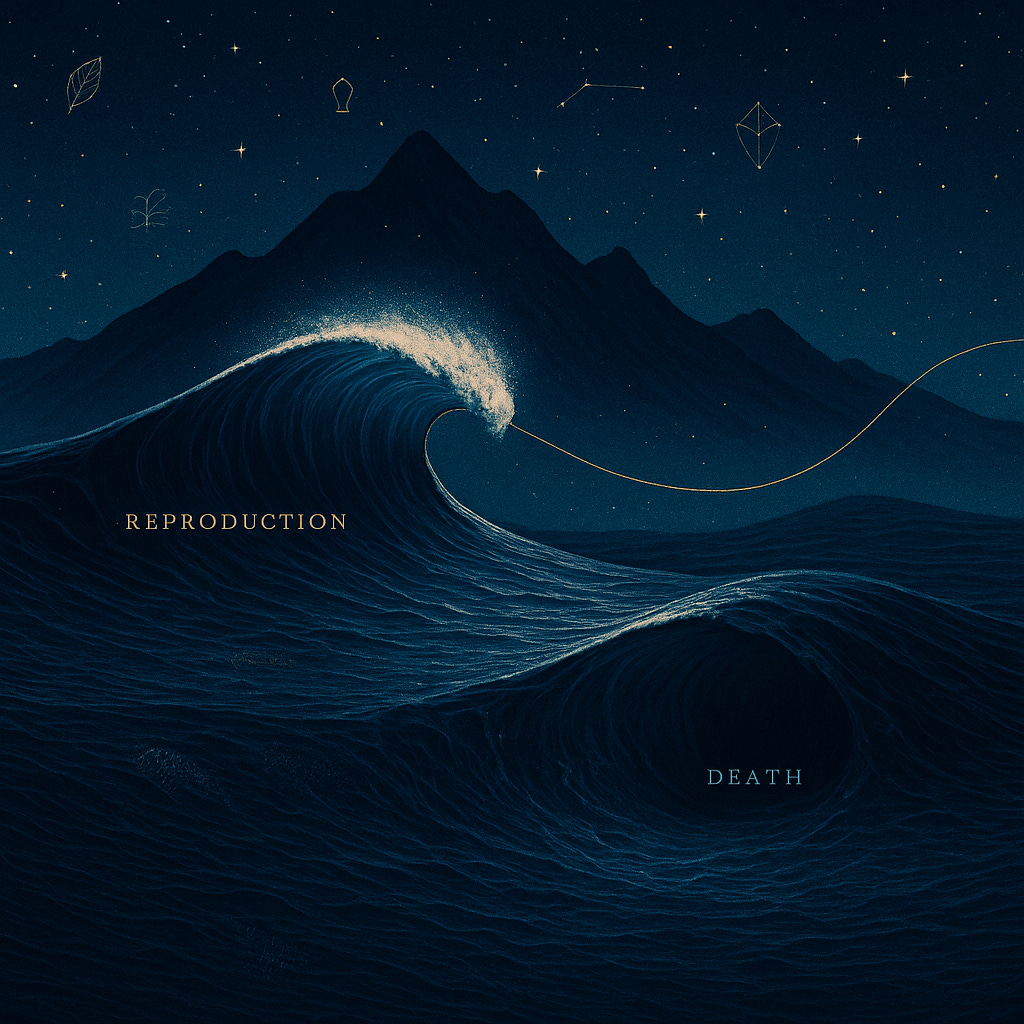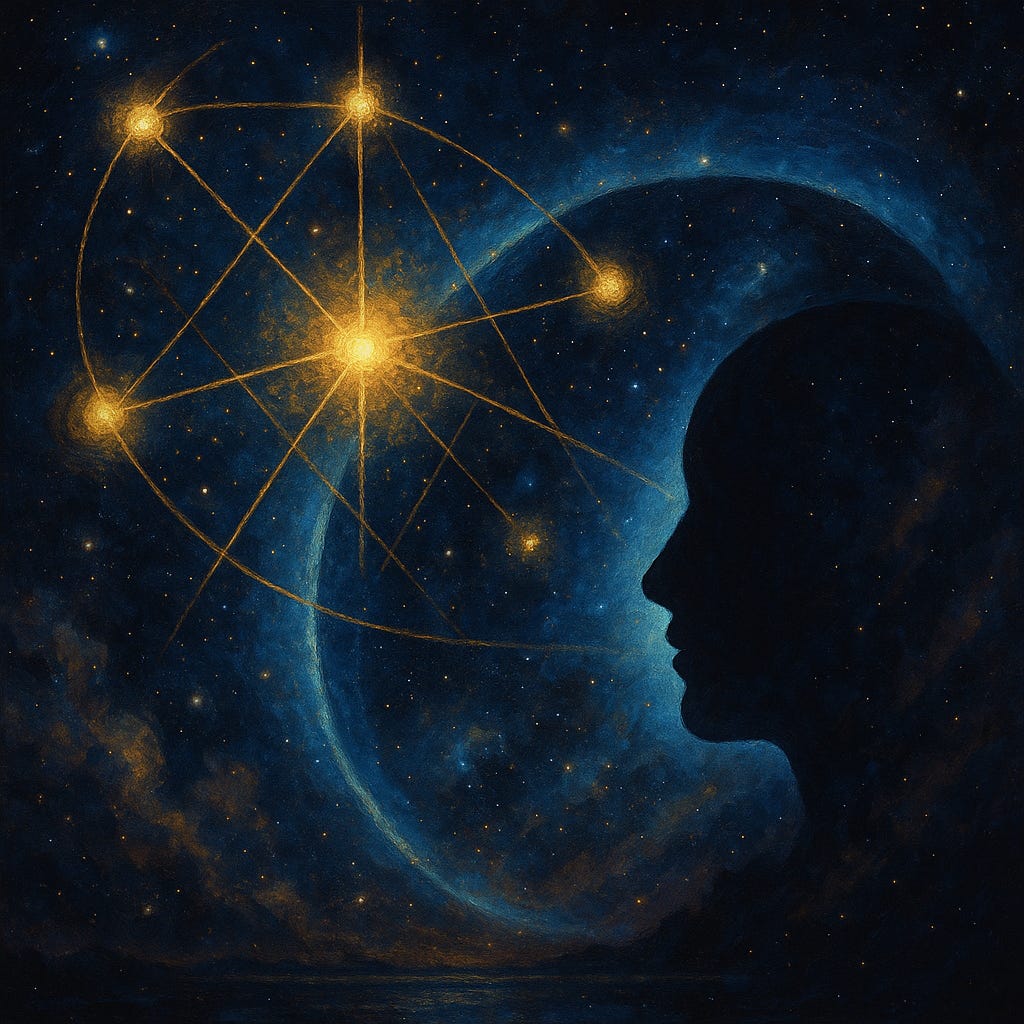✨ How ERT Unifies & Expands Our Understanding of Life
Part I The Big Picture: Eudaimonic Recognition Theory, Natural Selection & Personal Evolution
🌊 First Waves: What if evolution isn’t a contest of genes, but a practice of getting better at being together?
What if meaning—what feels right, true, or aligned—helps shape what becomes real?
What if your choices don’t just change your life, but the field around you?
Eudaimonic Recognition Theory™ (ERT) is one of the core theories within Recognition Loops™. It says that evolution advances through recognition—feedback loops that optimise coherence across a shared field.
Consciousness is foundational; relationships are primary; and “fitness” is best read as the capacity to stay self-coherent while integrating novelty.
Genes and bodies are stabilised relational interactions. The engine that drives them? Recognition Loops. The coordinates? Five Fundamental Needs (5FN).

The Five Fundamental Needs: Why Your Relationships Are the Thread Holding Reality Together
🧵🔥 What If Your Deepest Needs Are Being Ignored?
Life advances by recognition—by systems (cells, people, ecosystems) learning, in recursive loops, which patterns keep them coherent (able to stay themselves) while integrating novelty (able to evolve). Do this long enough, and our loops stabilise into a shared reality.
As loops learn to satisfy the Five Needs, they combine signals from your inner and outer worlds, creating a bifurcated channel that synchronises and stabilises into reality.

Intrinsic and extrinsic channels interweave within the Recognition Field Matrix (RFM)—our stabilised, shared map—tending toward higher-quality coherence (depth over breadth).
In Eudaimonic Recognition Theory (ERT), the RFM forms at the intersection of Intrinsic and Extrinsic Sensitivity (IS/ES).
ES anchors phase-locked, measurable regularities of the external world; IS registers your interior stream—the pre-stabilised and nonlocal threads woven through you.
Pre-stabilised = Inherited and acquired priors carried as memory.
Nonlocal = Aspects of inner knowing/experience that are not yet measurable or phase-locked to the shared map (drifting from the WoR).
The compass is our Five Fundamental Needs (5FN). When inner signals and outer conditions support them, error falls, trust rises, and capacity expands. That’s coherence.
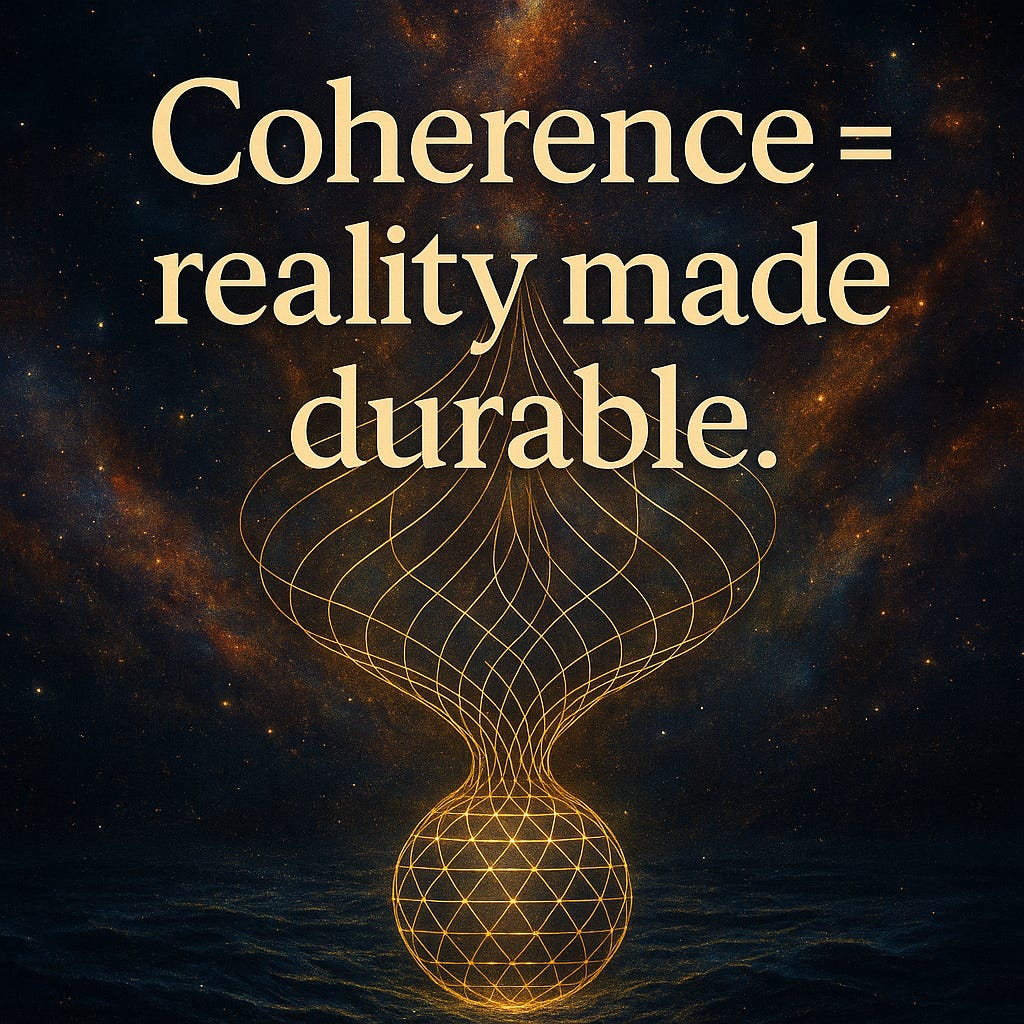
Recognition Loops operate on three contingencies—Inner (self → self), Outer (world → world), and Core (self ↔ world).
Together, they stitch perception and action; when aligned, they stabilise in the RFM.
Consciousness as the Foundational Structure (CFS) is the loom; Recognition Loops are the architects of change.
Patterns of “when I do this, the world does that,” refined by the self–other dynamic, emerge into a shared RFM of relational intelligence and perceptual reality.

This is a two-part piece:
Part One (you’re here): “The Big Picture”, coherence, and the Five Needs explain the felt “click” of alignment and how reality seems to meet you (more than) halfway when you’re aligned.
Part Two: 20 Reasons Why ERT Unifies & Expands Our Understanding of Life—crisp, testable claims with what each one means for you.

🖼️The Big Picture: Coherent, Intelligence Self-reference
A complex system—like you—shows greater intelligence when it stays coherently self-referential while integrating novel information.
All beings flourish as their loops align with their needs.
When our Five Needs are met, our sense of wellbeing rises and our perceptual reality expands—more coherent, more stable and open to expansion.
When they’re deprived, our lives dissolve into perceptual incoherence; reality contracts and fragments—ultimately toward extinction.
In ERT, the Five Fundamental Needs are eudaimonic* (coherence-enabling) constraints: meeting them on both channels (ES outer fit, IS inner integrity) lowers error/friction so loops phase-lock into the RFM.
When a need is satisfied on both channels, loop friction drops and the pattern phase-locks into the Recognition Field Matrix (RFM); when unmet, loops drift back into the Weave of Reality for recycling.

Use the checklist cross-species to design for coherence—deepen coupling, protect and enrich the needs, clarify signalling, and balance inner qualities with external quantities.
*See glossary
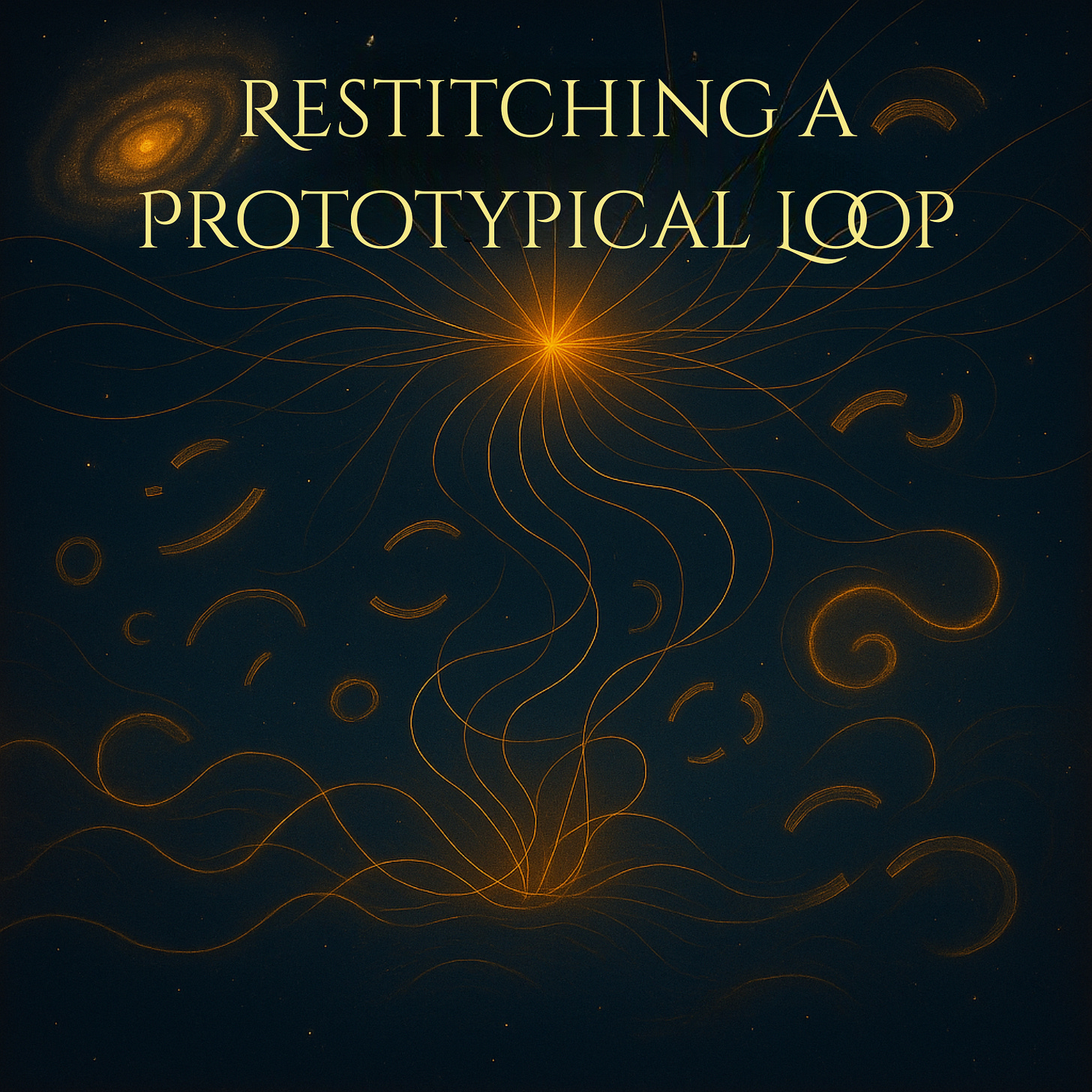
📷 Gathering Information from Reality
Stabilised loops don’t stay fixed forever.
When conditions shift—needs go unmet, incoherence rises, or new nonlocal inputs arrive—some phase-locked patterns in the RFM lose stability and slip below threshold.
They re-enter the WoR as drifting fragments and prototypes to be recombined, reweighted, or retired. From there, they may be re-stitched into the RFM in updated form or taken up by other RFMs (other groups, species, epochs)—spreading, mutating, or seeding new stabilisations.
Consciousness as the Foundational Structure (CFS) is the living loom.
The Weave of Reality (WoR) is the reservoir of patterns and possibilities.
The Recognition Field Matrix (RFM) is the stabilised, shared map we live within.
The world remains in constant flux, as differences emerging from the WoR exceed the current RFM and have not yet settled into our 3D perceptual range.
Recognition Loops pull these differences in, test them, and—when they raise coherence (meet the Five Fundamental Needs across IS/ES with less friction, preserve self-coherence, and reduce prediction error. Stitch them into the weave; otherwise, they drift back toward the WoR.
The RFM is therefore continually refined and pruned for shared coherence.
‘Now’ is the crest of a 3D wave—the phase-locked slice of the weave, stitched one recognition at a time—the aggregate of stabilised Recognition Loops in the RFM, which creates the appearance of linear flow.
Sense: Five Needs set the coordinates; IS (self-awareness) hears faint threads early and threads novelty; ES (other-awareness) locks to shared structure.
Perception: Your Range of Awareness widens as nonlocal threads become legible; Stitches in Time (SIT) bind moments into lived continuity.
Emotion: Emotion is a recognition gauge: pre-emptive (fear-based) flags future threats and opportunities; retroactive (loss-based) flags past mismatches; emergence signals a novel (coherent) fit.
Attitude: Repeated updates form complexes (loops within loops), shape your values and identity—via continual recursive recalibration.
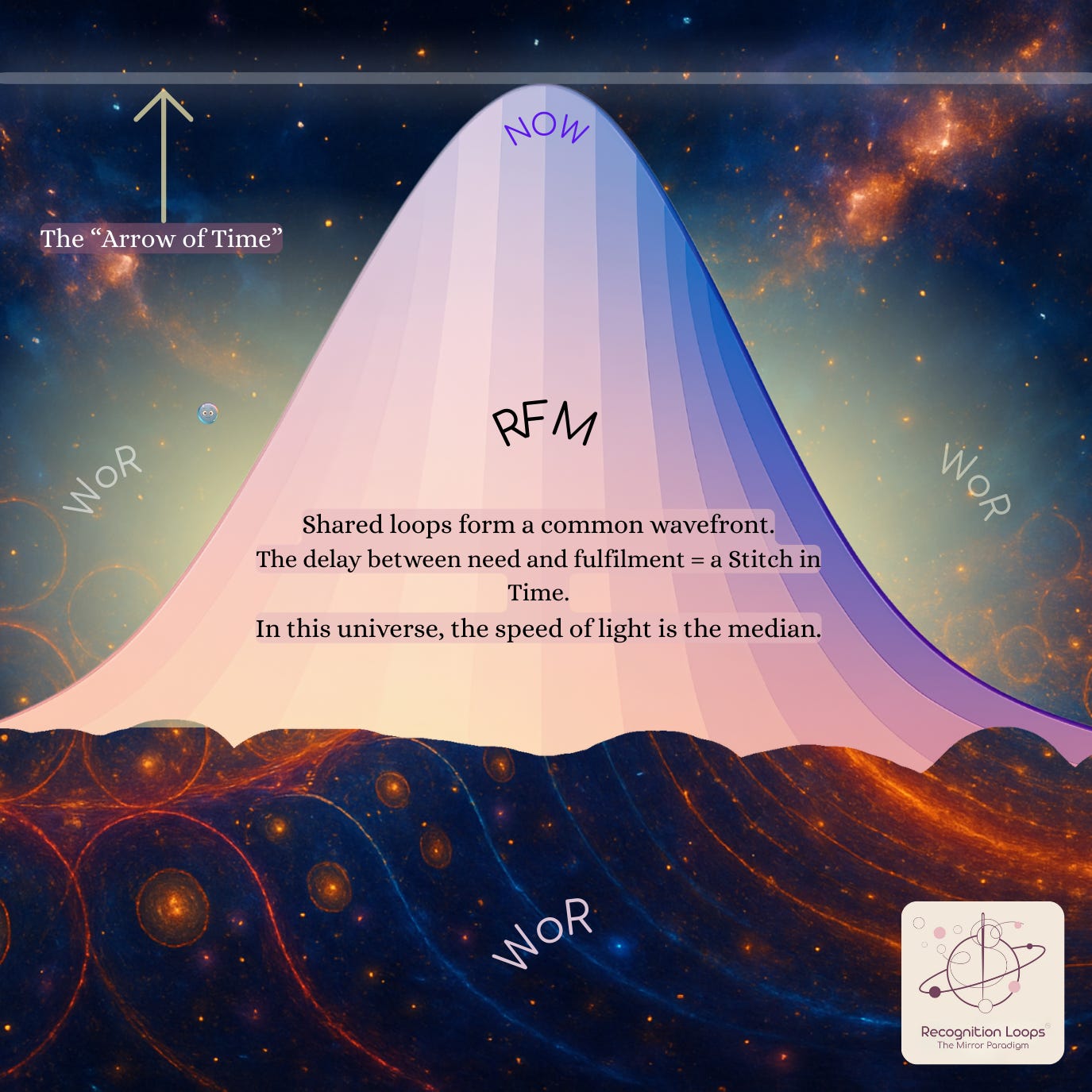
Four Types of Information
1️⃣ In-model (mutually recognised, ordered) — Signals the RFM already expects—highly conserved patterns (e.g., inorganic matter, genetic and developmental priors).
They refine what you “know,” tightening predictions and reducing everyday uncertainty.
You are not born a blank slate; you arrive with deep priors—shaped by an unbroken ancestral chain of stored Recognition Loops.
Your consciousness arrives pre-programmed with a living blueprint of Recognition Loops, carried forward through aeons of relational memory—dating back to the Dawn of the Universe.
Discover how these deep priors trace to the early universe: Plasma Visions 🌌🧵 — The Universe Awakens 🔽
2️⃣ Out-of-model (partially or unrecognised patterns, potential or chaotic, disordered information) — Signals the RFM does not yet expect—anomalies, edge-cases, and novel patterns that do not align with the current map.
These signals force continual model expansion and diversification: new categories, new relations, new skills.
This is where fresh priors are born—today’s surprises becoming tomorrow’s “reality”.
Handled well, out-of-model inputs rethread your loops so you stay coherently self-referential while remaining flexible and integrating novelty.
Handled poorly, novel information is dismissed as incoherent noise, and your RFM ossifies.
This is how living systems expand their intelligence: by converting surprise into a coherent relationship.

3️⃣ Nonlocal (relational reach beyond the current map, including quantum nonlocality)
Signals that link causes and effects across distance—through space, time, and scale—including entanglement-level correlations that exceed classical locality while preserving no-signalling (Einstein’s “spooky action at a distance”).
We register—implicitly, outside our current Range of Awareness—far more than classical sensory models suggest.
By placing human minds, consciousness, and language outside of nature—or relegating them to mere epiphenomena*—we estrange ourselves from the deepest, most intelligent layers of reality. In ERT, our inner world and language are elements of a universal sensory system.
We measure distribution shifts across a cohort or generation—not a single, timestamped moment when change “happens.” Mechanism, timing, and locus aren’t observed in situ; they’re inferred from population signals (trait shifts, survival/reproduction patterns, allele-frequency changes, selective sweeps).
Modern evolutionary theory recognises deep interconnectedness yet records outcomes as discrete proxies so we can do the maths. That productive paradox is powerful for classifications and statistics, but it compresses a continuous process into point-like events—and ignores inner experience.
Standard theories mainly trust the loud, repeatable signals—the ones our shared perceptual system already locks onto. Because of that, they tend to ignore the faint, early, or nonlocal cues that Intrinsic Sensitivity detects before things fully “settle” into standard view.
We have been conditioned to perceive changes mechanistically, assuming that we only recognise and respond to the most stable constants in our environment. This perspective suggests that life identifies objects, movements, and straightforward transactions.
This is like saying da Vinci’s artistic genius is like a two-year-old with crayons.
Our sensory perception acts like a cosmic architect and engineer, effortlessly crafting 3D realities within the mind. It doesn’t depend on strict objective measurements or fixed facts but flourishes in the spaces in between.
Patriomorphic bias has reduced evolutionary theory (and our sensory perception) to blunt instruments; in the ERT view, they are quantum-informed, finely tuned, reality-weaving systems oriented toward coherence optimisation.

We’ve mistaken perception for a mechanical detector of fixed things. ERT frames it as a quantum-informed, coherence-optimising builder of reality—far beyond the blunt, patriomorphic story we’ve been sold.
Nonlocal cues prompt us to deepen and refine the mesh of relationships—raising coherence (quality over quantity) by strengthening or pruning long-range links, clarifying hidden mediators, and coordinating cross-scale dependencies across beings, places, moments, and scales.
ERT treats change as a continuous field process: countless micro-updates in Recognition Loops bias the weave toward coherence.
What we label a “discrete event” is a threshold crossing—the moment a pattern phase-locks into the RFM—a visible crest on an ongoing wave. Under ERT, events are thresholds, not points.
This is how intelligence gains bridges, not just roads.
Intrinsic Sensitivity (IS)—your inner world (emotion, intuition, interior patterning, and a felt sense of “knowing”)—registers more: pre-stabilised, fluid threads flowing in from the WoR.
In other words, you don’t only know what is known; your consciousness continually registers what it hasn’t yet recognised and draws those novel threads toward reality!
Integrated well, today’s faint threads become tomorrow’s in-model constants; ignored, they linger as synchronicities, hunches, or background discordance we tune out.
The human world suffers under a patriomorphic bias that over-values external signals (resources, outward regularities) and under-values interior, not-yet-measurable signals—skewing recognition and reducing coherence.
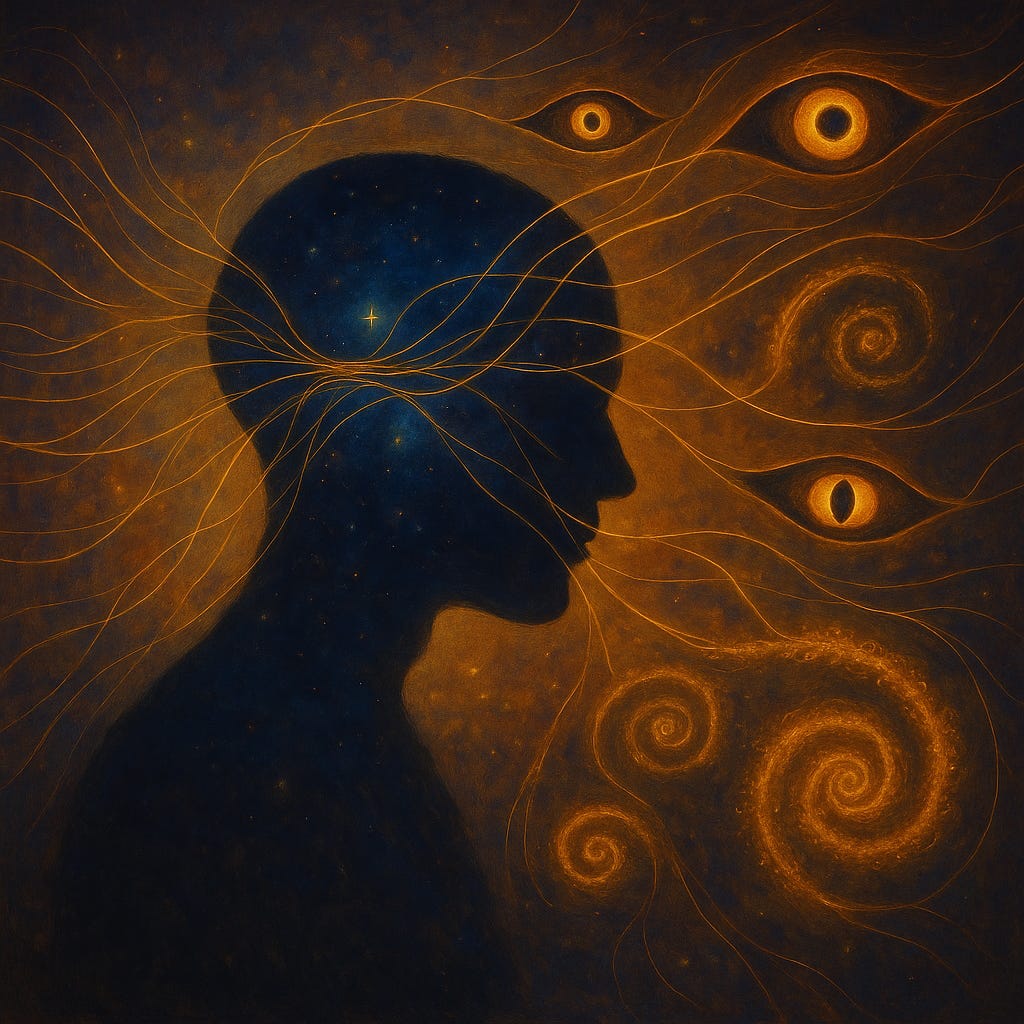
Coherence = Harmonious relational alignment
Neglect what cannot yet be measured or precisely defined, and we become less intelligent, not more. Less loving and harmonious, not more.
Rebalancing IS ↔ ES restores alignment and expands the relational intelligence the RFM—and everyone within it—can stably hold.
That lens leads us to dismiss inexplicable feelings, subtle events, interior sensations, immeasurable patterns, and nonlocal phenomena—accessed through our inner worlds—as insignificant.
Patriomorphic bias misrecognises Intrinsic Sensitivity (IS) as an anomaly rather than an exquisite channel of reality. With each recursion of denial, incoherence deepens.
The tragedy is that, by disowning IS, we blunt lived reality into a brutal instrument, hell bent on self-destruction.
An extreme, imbalanced focus on ES is—quite literally— self-betrayal, self-denial, self-abandonment, and, ultimately, self-collapse. It’s like pouring into a pot that continually empties itself.
The imbalance stalls our highest potential, conditioning us to bypass our inner world—our most valuable resource—in favour of external performance and metrics.
Consciousness as the Foundational Structure (CFS) continually draws on nonlocal information from the Weave of Reality (WoR), much of it pre-stabilised (not yet phase-locked to the shared RFM).
IS—felt as emotion, intuition, and your interior sense of self—detects sub-threshold structure, nonlocal potential, and novel patterns, bringing them toward awareness.
Without this capacity, shared structures cannot regenerate—they lose the fluidity and adaptability required to meet environmental and relational pressures.
What your inner world imagines is your gift to the universe: the impression you leave on everyone and everything around you—that is your unique offering and highest purpose.
Interior worlds drive evolution: life, nature, and the observable world organise at the seam between Self (IS) and Other (ES).
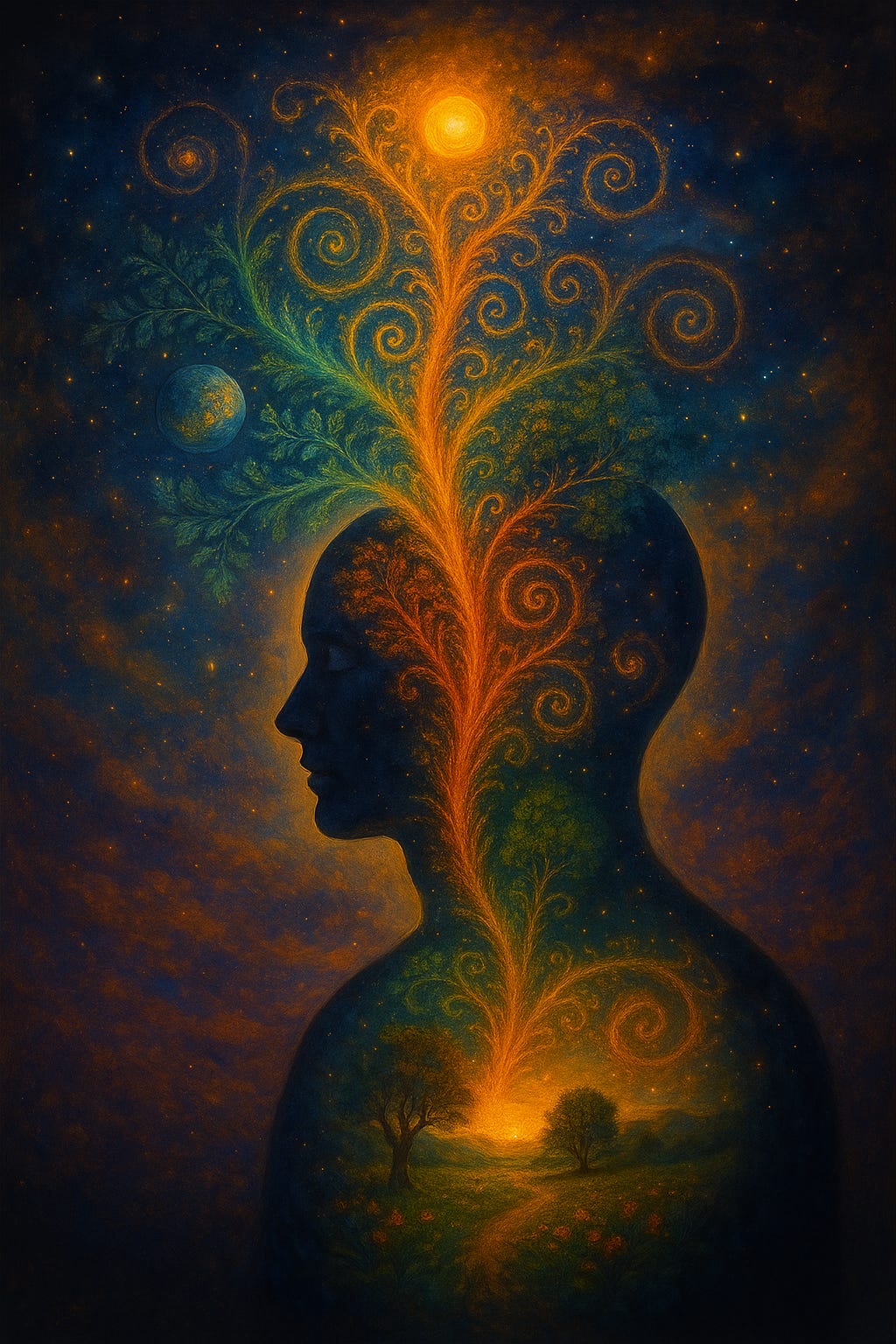
Recognition Loops stitch those seams, weaving a field matrix of shared perceptual reality through our relationships. Self and Other are inseparable. The nature of reality is the bond.
Increase coherence—meet the Five Needs across IS/ES with less friction, while preserving self-other coherence—and phase-lock patterns.
When coherently aligned, what you imagine enters the RFM as tomorrow’s observable reality.
🧭What This Means For You:
Fewer mixed signals and a steadier inner focus mean your choices stop fighting your feelings. Trust rises, and you can nurture deeper relationships and experience enormous life gains without falling apart.
Balance IS ↔ ES and friction drops: you spot good fits earlier, exit mismatch sooner, and life supports deeper commitments with less effort—the field starts to work with you! In fact, once coherence phase-locks, you can expect threshold-type gains!
Check out this article explaining this phenomenon!
4️⃣ Coherence optimisation drives evolution (ERT). Loops that integrate more novelty while remaining self-coherent propagate—biologically, culturally, personally.
When the Five Needs are met, wellbeing rises and perceptual reality expands—more stable, more capable, more open.
Under chronic deprivation, loops degrade and reality contracts—your Range of Awareness shallows.
We evolve by recognising and integrating differences from the WoR—especially the unrecognised, nonlocal, and chaotic—upgrading the RFM so we can stay ourselves while expanding and diversifying.
🌊 ERT & the “Wave” of Evolution
Contemporary evolutionary theory recognises interdependence yet operationalises change as discrete signals. It’s a productive paradox—great for measurement, partial for flow.
In the field, you see distribution shifts across a cohort or generation, not a single, timestamped moment of change.
Mechanism, timing, and locus aren’t observed in situ; they’re inferred from population signals (trait shifts, survival/reproduction patterns, allele-frequency changes, selective sweeps).
ERT suggests that change is a continuous field process. What we call an “event” is a threshold crossing—the moment a pattern stabilises into the RFM, a visible crest on an ongoing wave.
Under ERT, events (evolutionary change) are thresholds, not points. Collective, not personal.
ERT reframes evolution as a continuous, relational wave oriented toward coherence. It predicts a coherence-oriented (benevolent) drift: systems tend to preserve self-coherence while expanding tightly coupled, harmonious relations.
What we usually measure—especially in genetics—is the stabilised crest of that wave.
ERT says evolution is a continuous wave, not a string of separate mutation events. Every interaction—within you and between you and everything else—updates the Recognition Field Matrix™ in real time.
♻️ Recycling of Patterns
When conditions shift—noise rises, needs go unmet, or new nonlocal inputs arrive—some stabilised patterns drift beyond our RFM.
They return to the WoR as fragments and prototypes to be recombined, reweighted, or retired. From there, they may be re-stitched into our RFM in updated form or taken up by other RFMs (groups, species, epochs)—spreading, mutating, or seeding new stabilisations.
Phenomenology first, record later.
CFS weaves stabilised Recognition Loops (shared patterns) with nonlocal novelty (as-yet unrecognised information) into lived experience.
We register reality first as valence, perception, meaning; only later do those impressions crystallise into the material record as physiology and, eventually, genomic change.
Evolution looks slow in retrospect because we’re observing the long-lived crests, not the fluid under-pattern that produced them.
🧭 The Engine & the Compass
The engine of evolution is our collective Recognition Loops tuning toward coherence; the compass is the Five Needs—read through sensation, emotion, and the attitudes shaped by accumulated relational memory.
“Big drivers” like reproduction and death are high-amplitude peaks—easy to recognise as attractors or repellors because they mark extreme fulfilment or deprivation.
Evolution’s work lives in the perpetual micro-adjustments of daily relating, where micro- and meso-scale attractors and repellors keep the field in motion.
🧠 Memory, Intelligence, Direction
Genes and bodies are the memory of these waves. Intelligence is the ability to remain self-coherent while integrating novelty. Direction is the optimisation of coherence across the whole field.
In this view, Consciousness is foundational, and Recognition Loops are the primary units of change: patterns of “when I do this, the world does that,” refined by the self–other dynamic into a shared matrix of relational intelligence.
🔬 The Science Bit: 🧬 The Selfish Gene — An ERT Update
The Gene-Centric View
In modern evolutionary biology, genes are treated as replicators and organisms as their vehicles.
Heritable variation and differential reproduction shift allele frequencies; altruism and cooperation are explained via inclusive fitness, kin selection, and game theory.
Richard Dawkins’ “selfish” is a metaphor for replication bias, not intention. Ideas like extended phenotype, niche construction, and multi-level selection have extended this view.

🌞 ERT’s Reframe
ERT keeps the “bookkeeping” (genes change; phenotypes shift) but changes the causal currency.
Genes as memory: Genes serve as lasting memory traces of deeper dynamics—Recognition Loops continuously refine a shared Recognition Field Matrix (RFM).
Valence everywhere: Interactions such as quorum sensing, immune signalling, mate choice, and coalition building carry valence—an inclination towards attractors and away from repellors—linked to the Five Fundamental Needs (5FN).
Preference is fundamental: From proto-responsiveness in cells and microbes to reflective agency in humans, a preference gradient directs recognition updates.
Consciousness participates: Recognition is conscious at higher levels and proto-valenced at lower levels; in both cases, loops rethread towards coherence (identity maintained while incorporating novelty).
Coherence filtering: Patterns that lower friction/error and satisfy 5FN across IS/ES phase-lock into the RFM; those that do not drift back into the Wor. This represents “selection” within the causal units of ERT.
🗻 Peaks & 🌊 Waves
Reproduction and death are high-amplitude peaks—extreme fulfilment or deprivation—so they stand out as stable, visible crests.
Evolution unfolds as low-amplitude swells—a continuum of fine adjustments threading bodies, hives, hosts, species and ecosystems.
🗺️ ERT Mappings
Fitness → Eudaimonic fitness: Capacity to stay self-coherent while integrating novelty.
Selection → Coherence filtering: Valenced patterns (those with a specified value - the 5FN) that maintain IS/ES alignment persist; misaligned patterns fade.
Genes → Lagging indicators: Gene-frequency shifts record prior field dynamics rather than drive them.
📒 Ledger vs. Cause 📈
The selfish-gene ledger tracks which patterns succeed in reproduction, exploit niches, and avoid untimely death. ERT explains why patterns persist—across the sublime, the extreme, and even the paradoxical and ridiculous!
Every relationship, at every scale, is preference-laden and nudges the field toward—or away from—coherence.
Life runs on recognition bias, not on replication bias —a subtle yet profound difference.
In real time, living systems privilege coherence-raising relational patterns that let them stay themselves while integrating novelty.
Natural selection is the scoreboard. Over generations, it records who reproduces, who survives, and by how much—that’s the ledger.
ERT defines how the score is determined by shifting the causal currency from replication to recognition: patterns that reduce friction between the self (IS) and others (ES), and promote diverse yet stable pathways to fulfilling our Five Fundamental Needs.
Like Narcissus, humanity stares into reality’s glass and mistakes self-replication for the whole.
In truth, life, consciousness, and evolution are less about self and other, and more about the liminal mirror glass between us.
The mirror continually tweaks the reflected images not as replication but to reveal each other in the best possible light.
Sensory perception tends the glass: it trims noise, resolves tensions and gaps, and phase-locks the most coherent threads possible into closed Recognition Loops; the rest drift away as unused possibility (potential information).
Amid chaos and the self♾️other push-pull, we prune irrelevancies and lock in coherence—to keep the mirror from cracking.
🔮ERT Assumptions & Predictions
In the short term, success is all about fit—how well your internal state aligns with the world around you. When IS↔ES are in sync, errors decrease, movements harmonise, and the system maintains its structure while adapting to new challenges.
These patterns are better predictors of survival and success than genetics. Genes capture the results, but coherence drives the process.
Coherence surpasses genes (near‑term). IS↔ES alignment → fewer mistakes, lower prediction error, synchronised action; stronger forecasts of thriving than genotype alone.
Small adjustments → step‑changes. Targeted, coherence‑enhancing nudges trigger threshold jumps in performance and resilience (depth over breadth). Genetic change is logged later.
Early warnings live in the Needs. Strain in any Five Fundamental Need (5FN) typically appears well before the fitness ledger turns red—treat it as your canary.
Endurance has a signature. When inner state and outer structure harmonise, error drops and movement synchronises—reliable signs of what will endure, from teams and relationships to reefs and ecosystems.
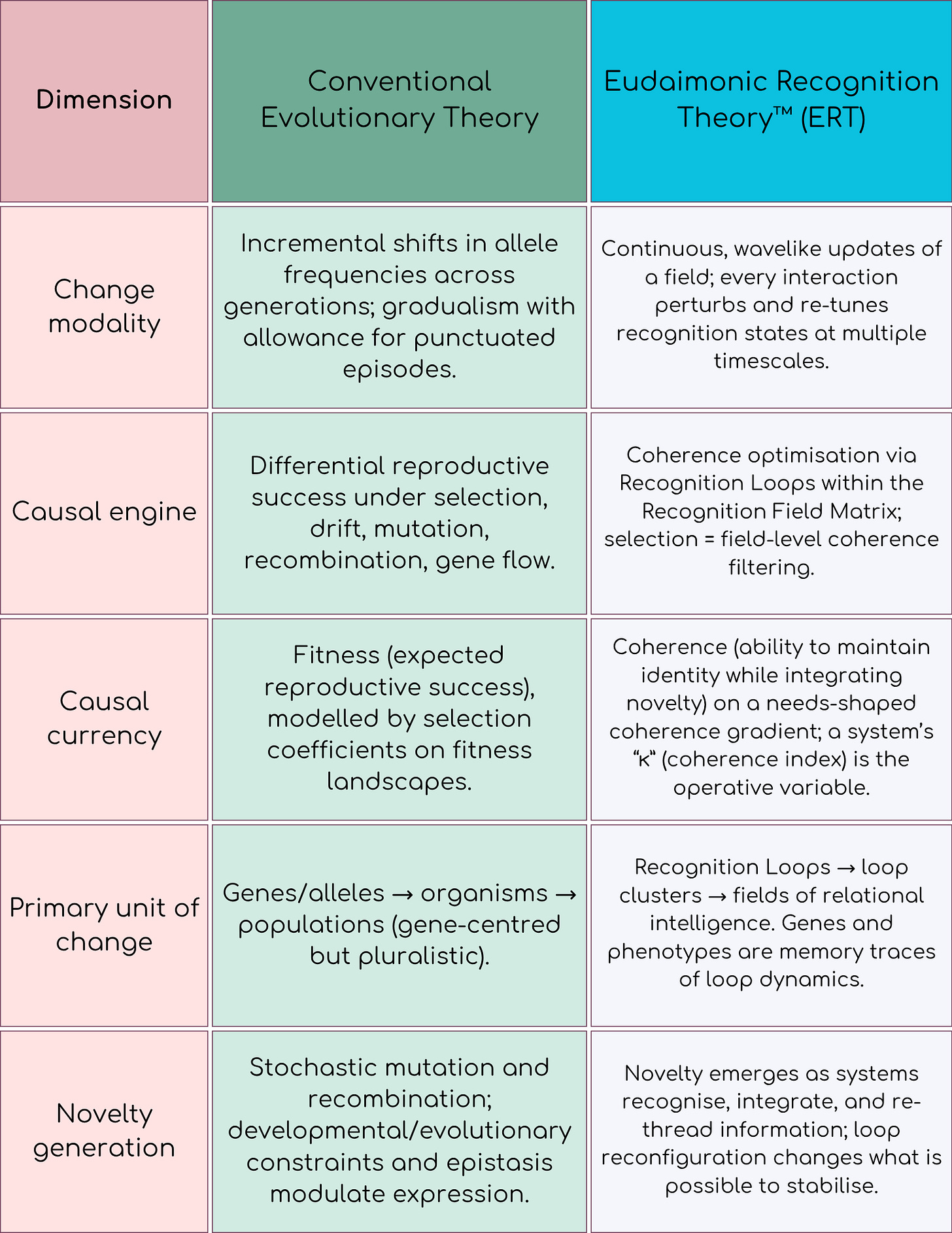
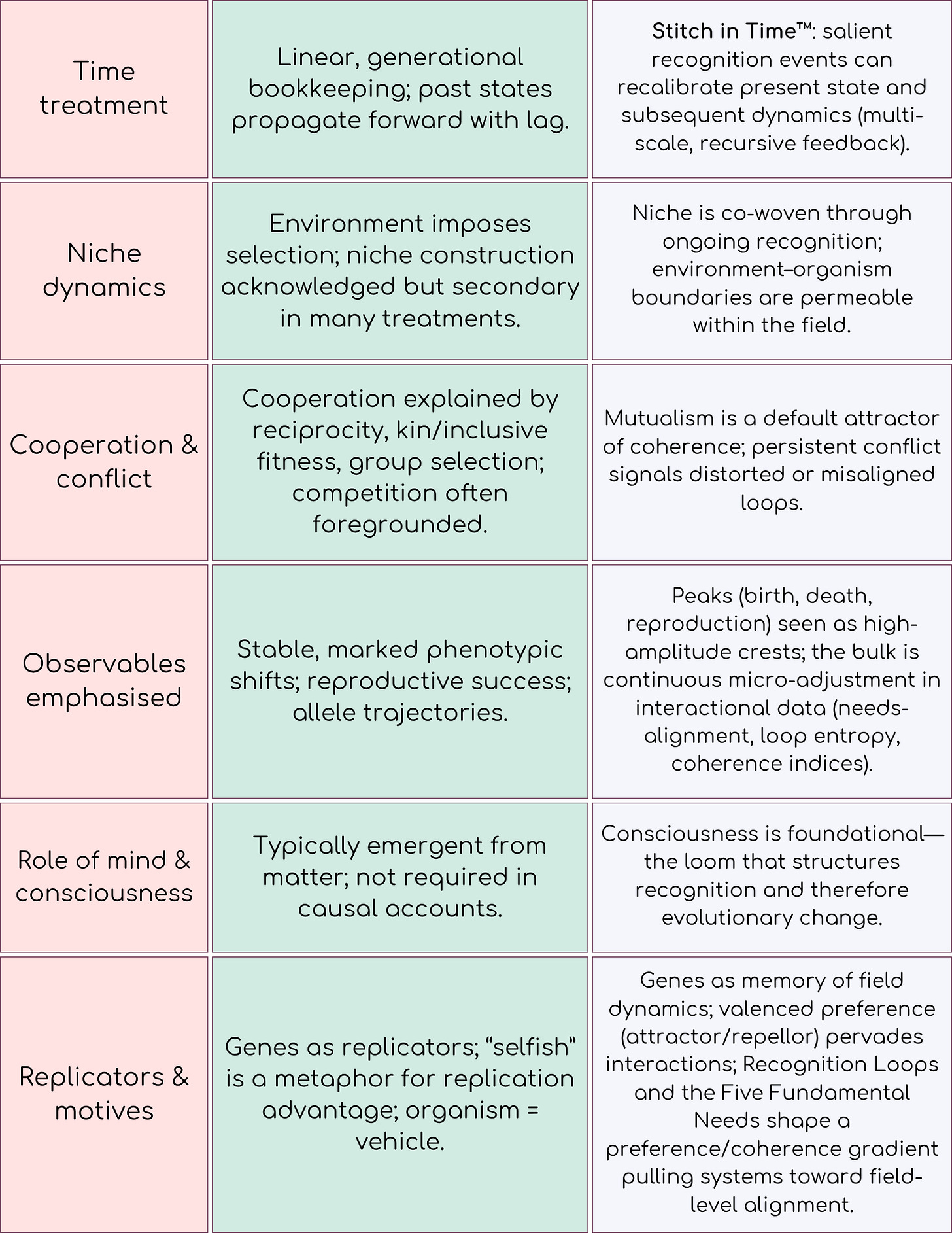
🧭What It Means For You: Coherence is the strongest predictor of thriving
Coherence is practical. In the near term, the strongest predictor of thriving is fit: your inner signals lining up with the structure you’re in.
When IS↔ES align, friction drops, decisions get cleaner, and capacity expands without you falling apart. That’s the lever you can pull today.
Use your Five Fundamental Needs as a compass.
Name the need(s) that are strained or deprived—then make the smallest move that raises alignment for you and the field.
Stabilise the gain with a loop: repeat, reflect, reinforce.
This is how tiny stitches compound into thresholds.
Design for coherence.
Curate roles and boundaries, add buffers and optionality, ritualise repairs, and make your meanings explicit.
In daily relating, ask one master question: “What would raise shared coherence here?”
Then do that—briefly, precisely, and soon.
💡 Summary — Do This Next
🔎 Scan: Quick IS↔ES check—does your inner “yes/no” “right vs wrong feeling” match external roles, rules, resources?
🧭 Name the Need: Which of the 5FN is calling?
🪡 Make One Stitch: The smallest act that raises total alignment.
🔁 Loop It: Repeat → Reflect → Reinforce; recursions become reality.
🧯 Repair First: Short, timely, precise repairs beat long explanations or extended efforts.
🧳 Add Optionality: Buffers, escape lanes, reversible steps.
📉 Track Three Signals: Prediction-error ↓, Synchrony ↑, Effort-to-outcome ratio ↓.
🌊 Expect Thresholds: Small, coherent moves often yield step-changes.
🪞Final Reflections: Life, consciousness, and evolution unfold in the liminal mirror glass between us.
Your perception tends that glass—wiping noise, resolving tensions, and stitching the threads that let us reveal one another in the best possible light.
You were not meant to sleepwalk through life.
You are not a passenger in a closed machine.
You are a co-weaver in a living field.
Where you place attention becomes architecture: each courageous, honest word; each wise boundary; each humble repair; each well-timed giving and receiving—these are Stitches in Time the universe uses to hold itself together.
The seam between self and other is where nature evolves, enfolding and unfolding into new coherence.
Every life leaves a legacy—not a monument, but an ever-widening signal of alignment others can lean on.
Part Two brings the toolkit and completes the picture: Recognition Over Replication — 20 Reasons Why ERT Unifies & Expands Our Understanding of Life.
You’ll get clear measures and simple protocols you can run with partners, friends, teams, and communities.
Selection keeps the score. Recognition writes your story.
✨ Summary — Hold This Close
🌫️ Clear the Glass: Rebalance IS↔ES so that meaning and structure agree.
🧵 Your Stitch Matters: Tiny, timely stitches compound into crests.
🧭 Meaning Is Data: Valence steers—treat feelings as directional signals.
🧱 Identity + Novelty: Keep form while taking in the new—coherence, not control.
🤝 Relationship Is Reality: Ask what raises shared coherence, then act.
🔔 Watch the Needs: Early strain is the canary—move before the ledger turns red.
📜 Live Your Thesis: Selection tallies; recognition decides, moment by moment.
🔜 Next: Part Two—metrics, playbooks, and field exercises to turn insight into durable change.
▶️ Coming Next — Part Two
Recognition Over Replication: 20 Reasons ERT Changes the Game
What Part Two delivers:
Proof, not poetry. Twenty crisp, testable reasons ERT unifies how life works—from cells to cities—plus what each one means for your day-to-day decisions.
Handles you can use. Three practical metrics (IS↔ES alignment, prediction-error drift, synchrony depth), a compact Coherence Checklist, and short field exercises to run with a partner, team, or community.
Threshold moments. How tiny, coherent stitches trigger step-changes (and how to spot one coming).
Design patterns. How to raise coherence without force: micro-repairs, role clarity, optionality, buffers, and ritual.
Evidence windows. Where the data already points (development, social insects, microbiomes, psychoneuroimmunology, niche construction)—and how ERT reads it as one story.
What you’ll be able to do by the end:
Forecast stability and performance before outcomes by tracking coherence signatures.
Run five-minute recalibrations that lower friction and increase capacity.
Map the liminal mirror glass between self and other—and tune it.
Build contexts that keep identity intact while integrating novelty.
Subscribe now so you don’t miss it!
Thank you so much for reading and supporting my work. There’s loads more to come!
😃💗
📚 Sources
Richard Dawkins, The Selfish Gene (Oxford: Oxford University Press, 1976; 40th Anniversary ed., 2016).
*Eudaimonic (adj.) — yoo-DAY-muh-nik
Origin: From Greek eudaimonia (“good guiding spirit”); in classical philosophy: flourishing or living well.
General meaning: Well-being is defined by flourishing, meaning, and virtue, rather than by pleasure or comfort alone (contrast: hedonic).
ERT meaning (precise): Describes patterns, conditions, or policies that are coherence-enabling—they increase a system’s capacity to stay self-coherent while integrating novelty and meeting the Five Fundamental Needs (5FN) across bifurcated channels: ES (outer fit) and IS (inner integrity). Eudaimonic patterns reduce error/friction and are more likely to phase-lock into the Recognition Field Matrix (RFM).
Key uses in ERT:
Eudaimonic constraints — Coherence-enabling conditions across IS (inner integrity) and ES (outer fit) that reduce error/friction, support novelty integration, and raise the chance of phase-lock into the RFM (structuring, not restrictive).
Eudaimonic fitness — A system’s capacity to maintain self-referential coherence (identity) while expanding capability under change: integrating novelty, recovering from perturbation, and meeting the Five Needs across IS/ES with low error.
Eudaimonic alignment — A state where IS and ES signals concur across the Five Needs; prediction/free-energy error drops, shared coherence/correlation depth increases, and range of awareness widens—typically preceding or marking phase-lock into the RFM.
*Stitched one recognition at a time
Stitches in Time (SIT)
ERT/RLMP Definition: The discrete recognition events that bind adjacent moments into a coherent sequence. A SIT occurs when a Recognition Loop commits an update that reduces error/friction, preserves self-coherence (identity), and meets the Five Needs across IS/ES, thereby phase-locking a slice of experience into the RFM. Many SITs in succession produce the lived continuity we call “now.”
Why it Matters:
Temporal mechanism: Explains how pre-stabilised inputs from the WoR become a linear, ordered (illusory) timeline—not just accumulated data.
Continuity & agency: SITs create the felt thread of self across change—enabling learning, planning, and uniquely personal contribution to flourish within reality.
Coordination: Shared SITs (across agents) raise collective coherence and deepen correlation, supporting joint action.
Operational Signals
Prediction/free-energy error ↓, model evidence/compression ↑ after an update.
Consolidation markers ↑ (stability/retention/generalisation over time).
Synchrony ↑ (e.g., within/between-agent coupling, mutual information), repair latency ↓ after mismatch.
Failure Modes
Under-stitched: fragmentation, dissociation, temporal “holes,” inability to consolidate.
Over-stitched (rigidity): rumination/compulsions; low novelty uptake; brittle identity.
Across all conscious life, a SIT is the instant a system recognises that lowering error and friction while preserving self-coherence, by meeting its fundamental needs inwardly (IS) and outwardly (ES).
In that moment, loose potential from the WoR phase-locks into the shared RFM: a cell updates a pathway, a forest routes warning signals, a flock turns as one, a mind reframes—and the world unfolds differently.
String enough SITs together and you don’t just remember events; you weave continuity—too few SITs and experience fragments.
Too many inflexible SITs and life fossilises—rigidity breeds fragility. Evolution—personal and planetary—rides on the quality of individual stitches collectively woven into the field matrix of reality.
*Epiphenomenon / Epiphenomena
Classical definition: A secondary effect that accompanies a process but is not causally efficacious—it rides along without feeding back. In the philosophy of mind, epiphenomenalism holds that mental states are mere by-products of brain activity (Huxley’s “steam-whistle” analogy).
ERT/RLMP lens:
Global claim rejected: Intrinsic Sensitivity (IS)—feelings, intuitions, inner models—participates in Recognition Loops; it modulates prediction error, updates policies, and contributes to Stitches in Time (SIT). Therefore, consciousness is not an epiphenomenon.
Local/limited use allowed: Some features can be epiphenomenal relative to a given outcome (e.g., a biomarker that covaries with stress but doesn’t change behaviour when manipulated).
Operational test (pragmatic): If intervening on X changes IS↔ES alignment, SIT density, coherence, or behaviour → X is causal (not epiphenomenal).
If X merely tracks Y and interventions on X do not alter the loop’s outcome,→ X is epiphenomenal for those outcomes.
Examples:
Likely causal: Naming an emotion reduces conflict and shifts choices → the inner state is not an epiphenomenon.
Often epiphenomenal: Pupil dilation tracks arousal but typically doesn’t drive the decision policy itself.
Why it matters in ERT: Mislabelling live signals as “epiphenomena” hides real leverage points. ERT treats inner experience as a first-class causal channel in coherence optimisation, reserving “epiphenomenon” for features that lack feedback into the loop.
📔Mini Glossary
CFS — Consciousness as the Foundational Structure: The universal capacity for recognition; the living loom.
WoR — Weave of Reality: The mixing layer where unrecognised/nonlocal/chaotic threads are tried against need‑fulfilment.
RFM — Recognition Field Matrix: The shared, stabilised map of patterns currently phase‑locked into perception.
IS / ES — Intrinsic / Extrinsic Sensitivity: Interior vs. exterior channels of information.
SIT — Stitches in Time: Binding of updates into lived continuity.
Patriomorphic bias: Systemic overweighting of ES over IS; correct by rebalancing.
Eudaimonic: Coherence‑enabling; oriented toward flourishing through alignment.


